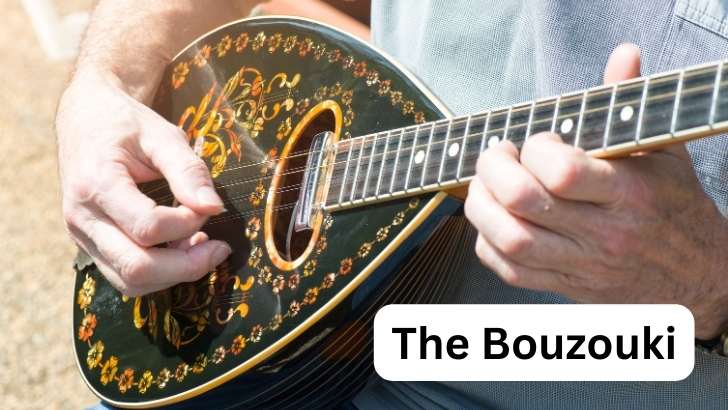
What is a Bouzouki Musical Instrument?
The bouzouki is a stringed musical instrument with a distinctive long neck and a hollow pear-shaped body, originating from Greece. It is traditionally played with a plectrum and has a sharp, metallic sound that is central to Greek music, especially in genres like Rebetiko and traditional folk.
In this beginner’s guide, we’ll review what the bouzouki musical instrument is by examining what it sounds like, how it’s played, its long history, how its made, and also explore some of the great tunes and compositions it has produced over its long and varied musical history.
Lets get started with some interesting Bouzouki facts that we will further explore within the article.
Bouzouki Instrument Facts
- There are mainly two types of bouzouki: the trichordo (three-stringed) and the tetrachordo (four-stringed), each offering a unique sound and complexity.
- The bouzouki is classified as a chordophone, a category of musical instruments that produce sound through the vibration of strings.
- The bouzouki is prominent in Greek and Irish folk music.
- Bouzoukis are typically made from wood, with spruce or cedar for the top and hardwoods like maple or walnut for the back and sides.
- The length of a bouzouki can vary, but it typically ranges from 65 to 70 cm, influencing the tension of the strings and the instrument’s tone.
- Although a traditional instrument, modern bouzoukis can be equipped with electronic pickups for amplification.
- Custom, handcrafted bouzoukis made by renowned luthiers can cost thousands of dollars, reflecting the craftsmanship and materials used.
- A musicians who plays the bouzouki are known as often referred to as bouzoukist.
What doe a Bouzouki Sound Like?
The bouzouki produces a resonant, twangy sound that is both vibrant and deeply melodic, capturing the essence of Greek musical tradition.
To truly appreciate its unique tone, watch the video below of a skilled musician playing the instrument. This will give you a firsthand experience of its captivating sound and the intricate techniques used to play the instrument.
How to Play the Bouzouki Instrument
The bouzouki has its roots deeply embedded in Greek culture and offers a distinctive sound that has captivated listeners for generations.
Traditionally constructed with a long neck and a round, hollow body, the instrument is played using a plectrum, which allows the player to strike the strings with precision and agility, producing its characteristic metallic twang.
Sound generation in the bouzouki begins with its strings, which are usually made of steel. The player manipulates these strings in two primary ways: strumming or plucking with the plectrum and pressing them down against the fretboard with the fingers of the other hand.
This action varies the pitch of the notes by shortening the vibrating length of the string. The bouzouki’s body, acting as a resonator, amplifies these vibrations, converting them into the rich, resonant sound that the instrument is known for.
The technique of playing the bouzouki involves a combination of strumming chords and picking individual strings, allowing for a wide range of musical expressions—from rapid, lively melodies to slow, heartfelt tunes.
The player’s skill in coordinating hand movements and controlling rhythm and tempo plays a crucial role in bringing out the instrument’s full sonic potential.
Additionally, the bouzouki’s unique sound is also shaped by its construction. The quality of the wood, the design of the sound hole, and the type and arrangement of the strings all contribute to its tonal characteristics.
Modern bouzoukis may incorporate electronic pickups, enabling amplification and further enhancing their sound for larger audiences or recordings.
Understanding the bouzouki’s mechanics and playing techniques reveals not just the complexity and versatility of the instrument but also the deep musical heritage it represents.
Through the hands of a skilled musician, the bouzouki bridges the past and present, producing music that resonates with the soul of Greek culture.
Different Types of Bouzouki Instrument to Learn
There are several types of bouzouki that enthusiasts can learn to play, each offering unique characteristics and sounds that cater to different musical preferences and styles. These variations not only enrich the instrument’s versatility but also allow players to explore a wide range of sonic landscapes.
Types of Bouzouki to Learn:
Trichordo (Three-Stringed) Bouzouki
- Pros: Easier to learn due to fewer strings, making it ideal for beginners. It has a traditional sound that is closely associated with early Greek folk music.
- Cons: Limited range of musical expressions compared to its four-stringed counterpart.
Tetrachordo (Four-Stringed) Bouzouki
- Pros: Offers a broader range of notes and is more versatile in playing modern and complex music. It’s favored by professional musicians for its rich sound.
- Cons: More challenging to master due to the additional string, requiring more advanced technique and practice.
Electro-acoustic Bouzouki
- Pros: Combines traditional acoustic sound with the ability to amplify the music, making it suitable for performances in larger venues.
- Cons: The electronic components may alter the natural acoustic sound, and it can be more expensive than purely acoustic versions.
Irish Bouzouki
- Pros: Adapted for Celtic music, it has a flatter back and often a wider fretboard, allowing for a different playing style and sound.
- Cons: It may not be suitable for traditional Greek music due to its structural and slight tonal differences.
Each of the bouzoukis mentioned offers a unique pathway to exploring the instrument’s rich musical heritage. Whether a player seeks the traditional sounds of Greek and Irish folk music or the broader expressions of modern melodies, there’s a bouzouki to suit every musical journey.
Musical Origins
The name “bouzouki” traces its origins to the Greek interpretation of Turkish and Persian influences, specifically from the words “bozuk” in Turkish and “bozuk saz” which means ‘broken’ or ‘modified lute.’ The instrument was embraced in Greece in the early 20th century, where it evolved and gained its distinctive characteristics.
Instrument History
| Era/Period | Bouzouki Development |
|---|---|
| Early 20th Century | Originated from similar long-necked lutes in Asia Minor and Turkey. It was introduced to Greece by Greek immigrants from Asia Minor. |
| 1930s-1940s | Gained popularity in Greece as part of the rebetiko genre, with the trichordo (three-string) version being predominant. |
| 1950s-1960s | The tetrachordo (four-string) bouzouki was introduced by Manolis Chiotis, expanding its musical range and versatility. |
| 1970s to Present | The instrument became integral to Greek folk and popular music, with further modifications including electrification for wider use in various music genres. |
| 21st Century | Advances in manufacturing and global interest have led to a diversity of bouzouki styles, including those used in fusion and world music contexts. |
The bouzouki has undergone significant transformation from its early origins as a simple stringed instrument of the Greek immigrants to becoming a cornerstone of Greek musical identity. Its development over the years reflects both technological advancements and the evolving tastes of musicians and audiences alike.
Key Parts of the Bouzouki
The bouzouki is made up of several key parts, each contributing to its unique sound and functionality. The primary components include the body, the sound hole, the neck, the fretboard, the headstock, the strings, the bridge and the pickguard:
- Body: The body, or sound chamber, is pivotal in shaping the bouzouki’s resonant sound. Traditionally crafted from wood, luthiers often use maple, walnut, or rosewood for the back and sides, while spruce or cedar is preferred for the top due to their superior sound projection qualities. Modern bouzoukis may incorporate synthetic materials for durability and consistency in sound.
- Sound Hole: Located in the center of the body’s top, the sound hole allows sound vibrations to escape from the body, amplifying the music produced. While usually round, the sound hole can also feature intricate designs or decorations, sometimes adorned with mother-of-pearl or abalone inlays.
- Neck: The neck of the bouzouki, extending from the body, is commonly made from hardwood such as mahogany or maple for stability and strength. It houses the fretboard, which is often crafted from ebony or rosewood, materials chosen for their durability and smoothness under the fingers.
- Fretboard: Adorned with metal frets, the fretboard divides the neck into segments, allowing for the production of different pitches. The choice of wood impacts the playability and the tonal characteristics of the instrument.
- Headstock: The headstock sits at the end of the neck and holds the tuning pegs. It can be made from the same wood as the neck or a contrasting type for aesthetic purposes. The tuning pegs, vital for tuning the strings, are traditionally made of wood or metal.
- Strings: Bouzoukis typically have steel strings, known for their bright, penetrating sound. The number of strings varies, with traditional instruments having three courses (trichordo) and modern ones four (tetrachordo).
- Bridge: The bridge, which anchors the strings to the body, plays a crucial role in sound transmission. Made from hardwoods like ebony or rosewood, it ensures that the vibrations from the strings are efficiently transferred to the body, influencing the instrument’s overall sound.
- Pickguard: Often made from plastic or wood, the pickguard protects the body from scratches and wear from strumming or picking.
From the resonant woods of the body and neck to the metal frets on the fretboard, every component is integral to the bouzouki’s musical expression.
This careful amalgamation of parts and materials not only defines the instrument’s character but also connects musicians to the rich cultural heritage of Greek music.
Famous Bouzouki Musicians
The bouzouki is not only celebrated for its unique tonal qualities but also for the skilled musicians who have mastered its strings. Here are a list of several renowned players who have brought its captivating melodies to the global stage and are worth listening out for.
Manolis Chiotis
Hailing from Greece, Manolis Chiotis was a virtuoso of the bouzouki and is credited with introducing the four-string bouzouki. His innovative playing style and compositions significantly influenced Greek music and helped popularize the instrument worldwide.
Vassilis Tsitsanis
Another Greek legend, Vassilis Tsitsanis, was a prolific composer and bouzouki player whose work during the mid-20th century played a crucial role in shaping the rebetiko and laiko genres. His songs remain classics in the realm of Greek music.
Mikis Theodorakis
Mikis Theodorakis is renowned for his extensive contributions to Greek music and culture, including his compositions for the bouzouki. His works, which blend classical and folk elements, have been instrumental in elevating the bouzouki to a symbol of Greek national identity.
Giorgos Zambetas
A celebrated bouzouki player and composer from Greece, Giorgos Zambetas was known for his emotional playing and distinctive sound. His contributions to Greek music have left an indelible mark on the bouzouki’s legacy.
Andy Irvine
Andy Irvine, from Ireland, has been instrumental in popularizing the bouzouki outside of Greece, particularly in Irish folk music. His adaptation of the instrument to Celtic music has inspired a new generation of musicians to explore the bouzouki’s possibilities.
Significant Bouzouki Music
If you are keen on following up on some outstanding traditional bouzouki compositions check out the following list of traditional folk tunes by some highly renowned composers.
“Misirlou” – Traditional, date unknown
A folk song from the Eastern Mediterranean region, “Misirlou” gained worldwide fame through its various renditions, especially in the Greek rebetiko style. Its exact origins are obscure, but it has been a staple of bouzouki players since the early 20th century.
“Zorba’s Dance” by Mikis Theodorakis (1964)
Composed by Mikis Theodorakis for the film “Zorba the Greek,” this instrumental is synonymous with Greek culture. Its rhythmic acceleration and joyous melody showcase the bouzouki’s lively character.
“Synnefiasmeni Kyriaki” by Vassilis Tsitsanis (1943)
Written during World War II, this song is one of Tsitsanis’ most beloved compositions, evoking a nostalgic longing through its melancholic melody played on the bouzouki.
“Strose to Stroma Sou” by Giorgos Zambetas
This classic piece, composed by Giorgos Zambetas, is a testament to his mastery of the bouzouki and his ability to convey deep emotions through its strings.
“To Vouno” by Markos Vamvakaris
Often referred to as the patriarch of the rebetiko genre, Markos Vamvakaris composed this piece, showcasing the bouzouki’s deep and resonant sound that embodies the spirit of Greek folk music.
“Horos Tou Sakena” by Yiannis Papaioannou
A significant figure in Greek music, Papaioannou’s composition features intricate bouzouki playing that highlights the instrument’s versatility and expressive range.
“Omorfi Poli” by Stavros Xarhakos
This piece by Stavros Xarhakos illustrates the bouzouki’s ability to capture the essence of Greek urban life and its complexities through its poignant melodies.
“Varka Sto Yalo” by Manos Loïzos
Composed by Manos Loïzos, this song is celebrated for its lyrical beauty and the evocative bouzouki passages that paint a picture of the sea and longing.
“Ta Kavourakia” by Manolis Chiotis
A tune that showcases Chiotis’ innovative approach to the bouzouki, blending traditional Greek sounds with modern influences, making it a joyful listen.
“Fragosyriani” by Markos Vamvakaris
Another masterpiece by Vamvakaris, this song captures the essence of the Greek islands and their musical traditions, with the bouzouki playing a central role in its melody.
The Bouzouki in Popular Culture
In addition to traditional folk music, the bouzouki has found a unique niche in popular culture, particularly within film, TV, and modern music.
Its sound, often associated with Greek or Mediterranean atmospheres, has been used to evoke a sense of place and emotion, transcending language and cultural barriers.
Below are four iconic tunes where the bouzouki’s presence has left an indelible mark on audiences worldwide.
“Zorba the Greek” – Mikis Theodorakis (1964)
Perhaps the most famous tune associated with the bouzouki, “Zorba the Greek” was composed by Mikis Theodorakis for the film of the same name. The track’s energetic rhythm and joyful melody encapsulate the spirit of Greek culture, making it instantly recognizable and a staple dance floor filler at celebrations.
“Never on Sunday” – Manos Hatzidakis (1960)
Composed by Manos Hatzidakis for the movie “Never on Sunday,” the song not only won an Academy Award but also introduced international audiences to the bouzouki’s charming sound. Its playful and uplifting tune has become synonymous with Greek music.
“The Godfather” – Nino Rota (1972)
Although primarily featuring traditional Italian scores, “The Godfather” soundtrack includes scenes where the bouzouki is used to emphasize the Mediterranean background of the characters. Its subtle inclusion adds to the film’s rich cultural tapestry.
“Inception” – Hans Zimmer (2010)
Hans Zimmer’s score for “Inception” uses a wide array of global instruments, including the bouzouki, to create its dreamy, intricate soundscape. While not front and center, the bouzouki’s inclusion underscores Zimmer’s commitment to sonic diversity and depth.
Instruments Similar to a Bouzouki
Exploring the world of stringed instruments reveals a fascinating array of instruments closely related to the bouzouki, each with its own unique characteristics and cultural background. Here are five more instruments closely related to the bouzouki which we think you might find of interest:
Oud
The oud is a pear-shaped stringed instrument commonly found in Middle Eastern music. It is considered a precursor to the European lute and, by extension, has historical ties to the bouzouki.
The oud lacks frets, which allows for a wide range of microtonal sounds, characteristic of Arabic, Turkish, and Persian music. Its deep, resonant sound provides a rich accompaniment to both traditional and contemporary music in its region.
Mandolin
Originating in Italy, the mandolin is a small, lute-like instrument with a short neck and eight strings, typically played with a plectrum. It shares with the bouzouki a bright, penetrating sound and the use of double-string courses.
The mandolin has been adopted in classical, folk, and bluegrass music, showcasing its versatility across various genres. Its crisp sound complements the bouzouki in ensembles, offering a lighter, more treble-focused timbre.
Saz or Baglama
The saz, also known as baglama, is a stringed musical instrument from Turkey that bears resemblance to the bouzouki in its long neck and body shape. It plays a central role in Anatolian folk music and has various sizes, each providing a different pitch range.
The saz is distinguished by its deeply emotional sound, capable of producing both melancholic tunes and lively, rhythmic melodies.
Balalaika
The balalaika is a Russian stringed instrument, recognizable by its triangular body and three strings. Although it differs in shape from the bouzouki, the balalaika shares the concept of a plucked string instrument contributing to folk and classical compositions.
Its unique shape and construction allow for a wide range of sounds, from the deep, sonorous bass balalaika to the high-pitched prima balalaika.
Cittern
The cittern, a Renaissance-era instrument that has experienced a revival in contemporary folk music, is another relative of the bouzouki. It typically features a flat back and a number of courses of metal strings, which give it a bright and jangly sound.
The cittern is used in a variety of musical genres, including folk, baroque, and Renaissance music, offering a sound that blends well with other traditional instruments, including the bouzouki.






